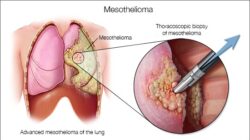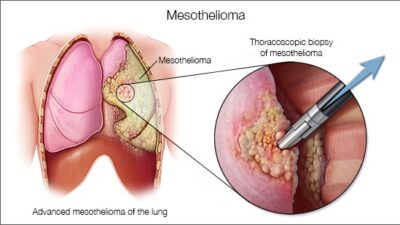Staging Mesothelioma cancer is finding out the extent of a patient’s Cancer and how far the primary tumor has spread in the body.
Staging is conducted to help identify any clinical trials the patient can participate in, as well as estimate prognosis & plan treatment options.
There are 3 main staging systems, detailed below, they are:
- Brigham System
- Butchart System
- TNM system
All 3 of these systems have the following in common:
- They detect the primary location of the tumor
- They determine the size & number of tumors that have developed
- They determine whether cancer has spread to nearby lymph nodes
- They determine the type of cells involved & grade of the tumor
- They look for development of Metastatic cancer
Here is an indepth look at each cancer staging system.
Mesothelioma Staging Systems
1. Brigham System
The Brigham system is used to determine the stage of development of malignant tumors in the lungs. The Brigham system is powerful in that not only does it measure the extent of tumor growth, it also indicates whether reductive surgery is a treatment option for the patient.
Brigham system is the least used mesothelioma cancer staging system because by the time mesothelioma is diagnosed, the tumor has advanced into very high stages and is usually not curable.
The Brigham system is made up of 4 distinguished stages each of which consider 2 variables; 1) capability of surgery to remove mass tumor from the lungs and 2) presence of cancer in the lymph nodes. The 4 stages of Brigham system are detailed as follows:
a. Stage 1
Any malignant tumors can be extracted or removed using surgery and there is no transfer or growth of tumors in the nearby lymph nodes. Tumors are confined within capsule of the parietal pleura, lungs, pericardium, diaphragm and chest walls.
b. Stage 2
Tumor masses that have developed in the pleura or the lungs can be removed with surgery, but cancer has spread to nearby lymph nodes.
c. Stage 3
Tumor masses can no longer be removed using surgery because cancer has spread to nearby organs such as diaphragm into the lining of the abdomen, heart and chest wall.
d. Stage 4
Tumor masses have metastasized (spread everywhere) and are carried into the nearby organs through the bloodstream. Areas where they can center include the brain, bones and other important organs of the body.
2. Butchart System
The Butchart system is the oldest & most commonly used Cancer staging system put in place to diagnose malignant mesothelioma.
The Butchart system measures the proximity and size of tumor masses residing in the lungs and is divided into 4 stages.
a. Stage 1
Malignant tumors have penetrated into the right or left side of the Pleural lining (chest cavity) and can be seen in the diaphragm.
b. Stage 2
Malignant tumors are present in the Pleura on both sides of the lungs and could possibly have been transported to the heart, stomach & the esophagus. Furthermore, tumor masses may have moved to the lymph nodes through the bloodstream.
c. Stage 3
Malignant mesothelioma has located in the Peritoneum (abdominal cavity) and lymph nodes around the chest.
d. Stage 4
Malignant mesothelioma has reached other organs of the body and is flowing through the bloodstream.
3. TNM System
The TNM is the newest Cancer staging system in place and stands for Tumor, Lymph Nodes & metastasis. It takes into account how far the cancer has spread (metastasis) and whether it has affected the Lymph nodes. It is also divided into 4 stages.
a. Stage 1
Malignant tumors are present in the right or left Pleura, and might have spread to the lungs, the pericardium (double walled sac enclosing the heart) or the diaphragm on the side. Malignant tumors have usually not spread to the lymph nodes in Stage 1.
b. Stage 2
Malignant tumors have translocated from one side of the chest cavity to lymph nodes near the lungs on the same side where the malignant tumors reside. Cancer has also spread to the diaphragm, pericardium and the the side of the lungs where the primary tumor lives.
c. Stage 3
Malignant tumors have moved into the chest linings, the heart, muscles, ribs & the esophagus as well as other important organs within the body. The cancer may or may not have spread to the lymph nodes.
d. Stage 4
Malignant mesothelioma has spread to the pleura and lymph nodes on the opposite sides of where the cancer is located. It may have also reached the chest cavities & lungs on both sides.
dr. Khadijah













